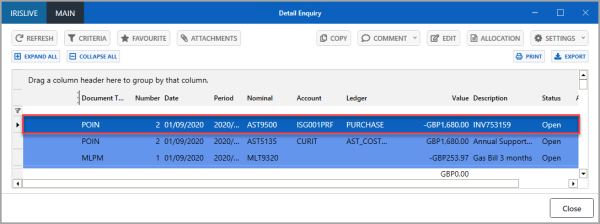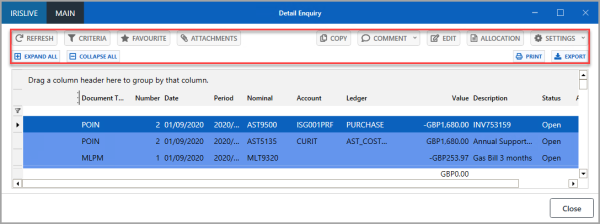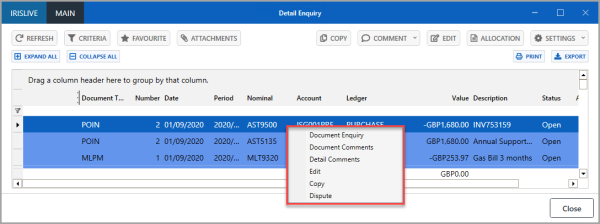Detail Enquiry Functions
Some Of the nominals and ledgers used in this topic may be different to those in your chart of accounts.
A detail enquiry (previously Account Enquiry) is used to view documents that have been added to IRIS Financials to record your establishment/organisation's transactions. From the Detail Enquiry window you can copy, edit, dispute, and allocate documents. You can also set the criteria to assist in exporting lists of documentation data or create reports. For more information, please see Running a Detail Enquiry.
To select a document on the Detail Enquiry window, select anywhere on the required document row. 
Detail Enquiry functions consists of the following:
Detail Enquiry Function Buttons
Personalising the Detail Enquiry
Detail Enquiry Function Buttons
The function buttons are located at the top of the Detail Enquiry window. Select the required document, then select the required function button to display the additional windows/dialogs or menus.
If a button is greyed out it means that option is not available for the selected document.

-
REFRESH - refreshes the data in the document panel, where any new documents that have been added since you ran the criteria are displayed.
-
CRITERIA - displays the Detail Enquiry Criteria dialog, where you can update the criteria for the enquiry.
-
FAVOURITE - displays the Add Favourite dialog, where you can save the enquiry to run again in future rather than having to select the criteria each time.
-
ATTACHMENTS - displays the Attachments for window, where you can view and maintain any attachments for that particular document.
-
COPY - displays the Document Input dialog, where you can create, amend and then post a copy of the document in journal format.
-
COMMENT - select from the options of add or view a comment or additional information, i.e. a more detailed description or information about a discrepancy to the overall document or to an individual item (detail) line, to display the Detail Comment or Document Comment dialog.
-
EDIT - displays the PSFJournal document input form window, where you can amend and post an updated version of the document. For more information, please see Editing and Reposting Documents.
-
ALLOCATION - displays the Allocation window, where you can allocate the document to a transaction. For more information, please see Allocating and Unallocating Documents.
-
SETTINGS - displays a drop-down menu from which you can save or rename column selections to personalise the Detail Enquiry window, or you can reset the columns and layout to default settings. For more information, please see Personalising the Detail Enquiry.
-
PRINT - displays the Print Preview dialog, where you can print a copy of the Detail Enquiry results.
-
EXPORT - displays the Save As dialog, where you can save a copy of the Detail Enquiry results as a Microsoft Excel format document.
Personalising the Detail Enquiry
If you frequently run detail enquiries for certain criteria that is displayed in fields that are not displayed in the default settings for the Detail Enquiry window, you can select the columns then save the settings to display them automatically when you run a future detail enquiry.
The following options are available for personalising a detail enquiry:
Selecting and Saving Columns as Default
Renaming Columns
Resetting Default Columns or Layout
Selecting and Saving Columns as Default
-
On the Detail Enquiry window, right-select on the column headings to display the column pop-up menu. Select to select the columns you want displayed or to remove a selected column from the display, then when you have all the columns you want displayed, select SETTINGS, then select SAVE AS DEFAULT COLUMNS.
Alternatively, to save the columns as default for all staff members using your organisation database, select SAVE AS SYSTEM DEFAULT COLUMNS.
-
The Save As Default Columns message is displayed. Select OK to return to the Detail Enquiry window.
Renaming Columns
If you want to rename a column to something more appropriate, for example one of the user fields that holds an accounts email address, you can rename the column heading in the Detail Enquiry.
-
On the Detail Enquiry window, select SETTINGS, then select RENAME COLUMNS.
-
The Rename Columns dialog is displayed. Select the column you want to rename, then overwrite in the Display Title column the name you want displayed in the column heading on the Detail Enquiry window, for example, Accounts Email, then select OK.
Resetting Default Columns or Layout
If you have removed or added columns to the detail enquiry that you no longer want displayed, you can reset the columns in the detail enquiry and the layout (which removes the column headings).
-
On the Detail Enquiry window, select SETTINGS, then select RESET DEFAULT COLUMNS (or to reset columns for all staff members using your database, select RESET SYSTEM DEFAULT COLUMNS).
-
The Reset Default Columns confirmation message is displayed. Select Yes to confirm the reset.
-
The Reset Default Columns success message is displayed. Select OK to return to the Detail Enquiry window.
Detail Enquiry Pop-Up Menu
The detail enquiry pop-up menu is displayed when you right-select on the selected document within the Detail Enquiry window. Select the required document, right-select, then select the required option from the pop-up menu to display the additional windows/dialogs or menus.

-
Document Enquiry - displays the Document Enquiry window, where you can carry out different functions for the document. For more information, please see Document Enquiry Functions.
-
Document Comments - displays the Document Comment dialog, where you can add or view additional information for the overall document, for example, a more detailed description or information about a discrepancy.
-
Detail Comments - displays the Detail Comment dialog, where you can add or view additional information for the an individual item (detail) line, for example, a more detailed description or information about a discrepancy.
-
Edit - displays the PSFJournal document input form window, where you can amend and post an updated version of the document. For more information, please see Editing and Reposting Documents.
-
Copy - displays the Document Input dialog, where you can create, amend and then post a copy of the document in journal format.
-
Dispute - changes the status of the document to or from Disputed. For more information, please see Placing Items in Dispute or Removing the Disputed Status from a Document.